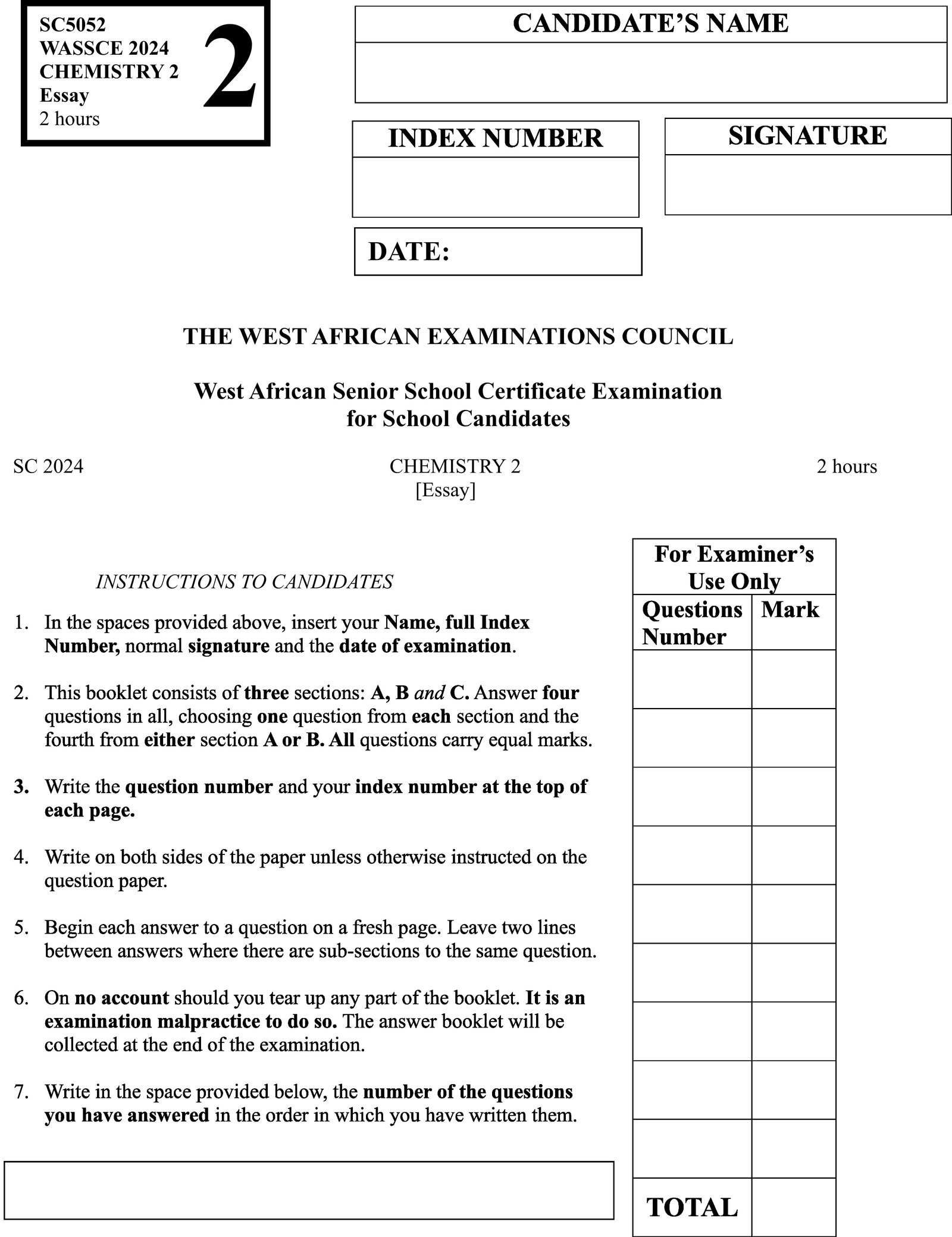

PAPER 2
Essay
[100 marks]
Answer four questions in all. Question 1 in Section A and three questions from Section B.
All questions carry equal marks.
Credit will be given for clarity of expression and orderly presentation of materials.
SECTION A
Answer all the questions in this section.
(b) State two factors that affect solubility.
[2 marks]
(c) An element Q has two isotopes, 3215Q and 3315Q, in the ratio 1 : 4.
Calculate the relative atomic mass of Q.
[3 marks]
(d) State the types of binding forces present in [Cu(H2O)4]Cl2
[3 marks]
(e) State three postulates of the kinetic theory of matter.
[3 marks]
(f) Explain briefly why the molecule of a gas has no fixed volume.
[2 marks]
(g) A gas occupies a volume of 200 cm3 at s.t.p. What volume would it occupy at 100 mm Hg and 27°C?
[3 marks]
(h) What is a weak acid?
[2 marks]
(i) State three chemical properties of acids.
[3 marks]
(j) Mention methods by which acids are prepared.
[2 marks]
SECTION B
Answer three questions only from this section.
(a) The atomic number of element Y is 13.
(i) Write the electron configuration of Y.
(ii) State the:
(I) Group to which Y belongs in the periodic table;
(II) Period to which Y belongs in the periodic table.
(iii) Write the formula of the oxide of Y.
(iv) Name the type of oxide formed by Y.
[6 mark]
(b) (i) Explain the term electrolyte.
[2 mark]
(ii) State three factors that could affect the preferential discharge of ions during electrolysis.
[3 marks]
2. (c) In the electrolysis of CuSO4(aq) using platinum electrodes:
(i) State the substance produced at the:
(I) Anode;
(II) Cathode.
(ii) State two effects of the electrolysis on the electrolyte.
[4 marks]
(d)
(i) What is global warming?
[2 marks]
(ii) Give two effects of global warming on the environment.
[2 marks]
(iii) State two ways in which global warming could be controlled.
[2 marks]
(e) Write the chemical equation for the reaction of ethyne with excess:
(i) hydrogen;
(ii) chlorine.
[4 marks]
(a) Give the general formula of each of the following groups of organic compounds:
(i) Alkanols;
(ii) Alkanoic acids.
[2 marks]
3. (b) On heating C10H22, it decomposes to octane and an alkene.
(i) Write an equation for the reaction.
[2 marks]
(ii) Name the process involved in 3(b)(i).
[1 mark]
(iii) State two conditions under which the reaction in 3(b)(i) would take place.
[2 marks]
(iv) Which of the products from the reaction in 3(b)(i) would undergo substitution reaction?
[1 mark]
(v) Define the term functional group.
[2 marks]
(c) (i) Complete the table below:
| Reactants | Formula of Product | IUPAC Name | Type of Bond Formed |
|---|---|---|---|
| H2 + Na | |||
| H2 + S |
(d) A chloride of iron contains 34.2% iron.
Determine its empirical formula.
[Cl = 35.5, Fe = 56.0]
[5 marks]
(a)
(i) List four apparatus used for the preparation of hydrogen.
(ii) Write a balanced chemical reaction equation for the laboratory preparation of hydrogen gas.
(iii) List four properties of hydrogen.
(iv) Give any four uses of hydrogen.
(v) What condition is necessary for a gas to be collected over water?
[15 marks]
(b)
(i) Explain why graphite is used as a lubricant.
(ii) Describe what would be observed when some piece of sodium is dropped unto the surface of cold water.
(iii) Write an equation for the reaction between sodium and water.
[7 marks]
(c) Name the drying agents for the following gases:
(i) Ammonia;
(ii) Hydrogen;
(iii) Sulphur (IV) oxide.
[3 marks]
(a) Write a balanced chemical equation for each of the following reactions:
(i) Ammonia gas with copper (II) oxide;
(ii) Ammonia gas with oxygen gas;
(iii) Aqueous potassium iodide with chlorine gas;
(iv) Iron with dilute tetraoxosulphate (VI) acid;
(v) Aqueous lead(II) trioxonitrate (V) with hydrogen chloride gas.
[10 marks]
(b) Describe briefly the process involved in the extraction of tin from tin ore.
[5 marks]
5. (c) State the class of oxide to which each of the following compounds belong:
(i) Na2O;
(ii) ZnO;
(iii) SO2;
(iv) CO2;
(v) N2O.
[5 marks]
5. (d) (i) Name two gases which can be used to demonstrate the fountain experiment.
[2 marks]
(ii) Give the components of the following alloys:
(I) Brass;
(II) Bronze;
(III) Steel.
[3 marks]